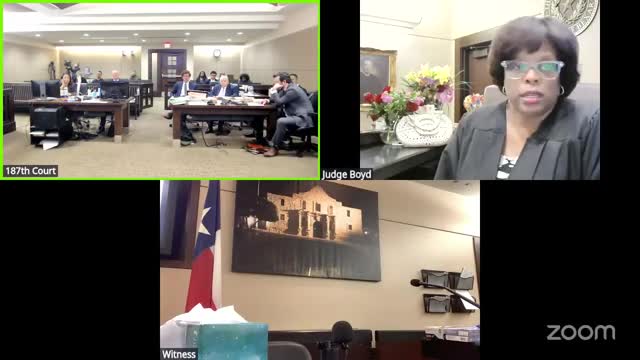Court examines deadly force in defense of property case involving Estrella's vehicle
April 09, 2025 | Judge Stephanie Boyd 187th District, District Court Judges, Judicial, Texas
This article was created by AI summarizing key points discussed. AI makes mistakes, so for full details and context, please refer to the video of the full meeting. Please report any errors so we can fix them. Report an error »

In a tense courtroom setting on April 9, 2025, Judge Stephanie Boyd presided over a pivotal hearing in the case of State vs. McIntyre, where the complexities of self-defense and property rights took center stage. The discussions revolved around the use of deadly force in defense of property, particularly concerning a vehicle involved in the incident.
The defense argued that the actions taken were justified under Texas law, specifically referencing Penal Code 9.42, which outlines when deadly force can be used to protect tangible property. The defense maintained that the deceased had engaged in aggressive behavior, including jumping onto the hood of a car and kicking the windshield, which they claimed shifted the burden of proof to the state to disprove their assertions of self-defense.
Judge Boyd acknowledged the gravity of the situation, noting that both parties agreed the force used was deadly, as it resulted in the death of an individual. The defense emphasized that the vehicle in question was movable property, thus falling under the protections outlined in the penal code. They argued that the circumstances warranted the use of deadly force to prevent imminent harm to the property.
The prosecution countered, asserting that the defendant's actions were not justified, suggesting that the defendant had provoked the situation by committing a robbery. They pointed out that the law requires a clear demonstration of imminent threat to justify such extreme measures, and they argued that the defense had not met this burden.
As the courtroom deliberated the nuances of the law, the discussion highlighted the delicate balance between protecting property and the potential for excessive force. The implications of this case extend beyond the courtroom, raising questions about the legal boundaries of self-defense and the responsibilities of individuals when confronted with threats to their property.
With the jury's decision looming, the case serves as a reminder of the complexities inherent in self-defense laws and the critical importance of context in determining the justification for deadly force. As the legal proceedings continue, the community watches closely, aware that the outcome could set significant precedents for similar cases in the future.
The defense argued that the actions taken were justified under Texas law, specifically referencing Penal Code 9.42, which outlines when deadly force can be used to protect tangible property. The defense maintained that the deceased had engaged in aggressive behavior, including jumping onto the hood of a car and kicking the windshield, which they claimed shifted the burden of proof to the state to disprove their assertions of self-defense.
Judge Boyd acknowledged the gravity of the situation, noting that both parties agreed the force used was deadly, as it resulted in the death of an individual. The defense emphasized that the vehicle in question was movable property, thus falling under the protections outlined in the penal code. They argued that the circumstances warranted the use of deadly force to prevent imminent harm to the property.
The prosecution countered, asserting that the defendant's actions were not justified, suggesting that the defendant had provoked the situation by committing a robbery. They pointed out that the law requires a clear demonstration of imminent threat to justify such extreme measures, and they argued that the defense had not met this burden.
As the courtroom deliberated the nuances of the law, the discussion highlighted the delicate balance between protecting property and the potential for excessive force. The implications of this case extend beyond the courtroom, raising questions about the legal boundaries of self-defense and the responsibilities of individuals when confronted with threats to their property.
With the jury's decision looming, the case serves as a reminder of the complexities inherent in self-defense laws and the critical importance of context in determining the justification for deadly force. As the legal proceedings continue, the community watches closely, aware that the outcome could set significant precedents for similar cases in the future.
View full meeting
This article is based on a recent meeting—watch the full video and explore the complete transcript for deeper insights into the discussion.
View full meeting
